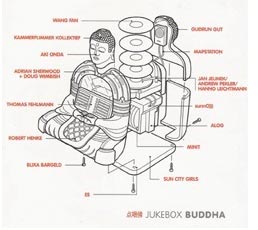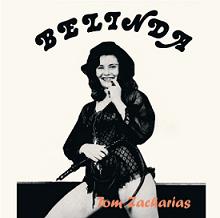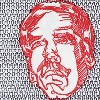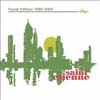- Administrator
- Albums and Singles
 The first compilation devoted to pieces made with the FM3 Buddha Machine includes 15 efforts by artists such as Blixa Bargeld, SunnO))), Kammerflimmer Kollektief, Adrian Sherwood + Doug Wimbish, Es, and Sun City Girls. Overall it achieves a collective consistency which may transcend what Derek Bailey called "lounge electronics, mumbling electronics."
The first compilation devoted to pieces made with the FM3 Buddha Machine includes 15 efforts by artists such as Blixa Bargeld, SunnO))), Kammerflimmer Kollektief, Adrian Sherwood + Doug Wimbish, Es, and Sun City Girls. Overall it achieves a collective consistency which may transcend what Derek Bailey called "lounge electronics, mumbling electronics."
I'm possibly one of the last brainwashed readers to learn that the two members of FM3 created the Buddha Machine, a plastic, battery-operated device resembling a pack of cigarettes or a cheap AM radio, containing nine different brief ambient snippets that loop endlessly. Whether their original idea was to subvert, mimic, or pay homage to chanting devices that have long been sold in temple gift shops all over China, is unclear and unimportant. Not surprisingly, Brian Eno wet his pants over the device, though to be fair his interest in endlessly self-mutating music is well documented and I mustn't let the fact that I don't yet have one color my comments. Some people buy several and play them simutaneously for the interplay, and it's said that a single device sounds different depending upon location. As with The Caretaker's recent meeting demand by supplying a six-disc set that was available for free download, and his gorgeous blue vinyl edition of Stairway To The Stars, here is further proof of the enduring seductive lure of a physical element in music packaging. The Buddha Machine may resemble the fetishistic magnetism of the i-pod, but in seeking to add nothing to itself, it is the opposite of that ubiquitous mini-library.
This record is the first commercially available attempt at compiling music derived specifically from those original nine loops. There might be a bit too much going on here for this album to be used as a tool for actual meditation, but generally the inactive listener isn’t distracted by much. Alog’s "A Dragon Lies Listening" where cooing gives way to nuances of Mongolian throat singing and choppiness, gets a bit worked up, but it could hardly be described as a barrage of glitch. Likewise, Jan Jelinek, Andrew Pekler and Hanno Leichtmann’s "BuddhaMachineCommercial" could sound like crass intrusion into the calm flow, but their welcome cheekiness recalls both the brilliant spoof ads of Sudden Sway and the unintentional humor of the recent Radio Thailand. The running order is good, especially when the slightly unholy and naturalistic twitter of "Little Yellow" by Blixa Bargeld is complimented by the splendid ethereal hum and quake of Es' contribution which follows.
SunnO))) provide "BP/Simple," an evolving 10 minute piece balancing beauty and restraint that whizzes by like an actual two minute 30 second jukebox hit. Minit also opt for less as more. In places, there are echoes of the work of Die Trip Computer Die and Tarwater, both of whom would have been interesting contributors. Elsewhere, on "Karma-Cola," Adrian Sherwood + Doug Wimbush perhaps predictably take the sound to bass depths which no one else approaches, while Thomas Fehlmann focuses on layering vocals pretty much unadorned.
Jukebox Buddha is a bright yet unflashy record worth returning to, and nicely rounded off by Sun City Girls' piece - the closest approximation of an Aboriginal gamelan mutation that I can recall. Unfortunately, now I believe the only way to cleanse myself of the impure desire to get eight of the original machines, each one a different color, turn them on, run a hot bath...is... to consumate that desire.
samples:
- Alog - A Dragon Lies Listening
- Jan Jelinek/Andrew Pekler/Hanno Leichtmann - BuddhaMachineCommercial
- SunnO))) - BP/Simple
Read More
- Scott Mckeating
- Albums and Singles
It starts slow and distant, ears needing to strain to distinguish the music from the world outside. This duo cello/percussion recording by Mêlèe is the sound of reality smeared across magnetic tape, a world unto itself.
Ben Hall and Hans Buetow balance intelligence and freedom in their inveterate playing here, both reinvent their instruments. The obvious communication is astonishingly prescient, tones rising like arterial strains of feedback. The cello comes out of the darkness like the foghorn of slowly sinking ships once bound for meat markets. The stretch and scuff of metal has he sound of an arcane musicality, but with the precisions of practiced improvisation. This single track is a rudimentary exploration of the now, at times both harsh and beautiful. The organic basis of their sound brings the sound of signal overload that comes and goes without the battering of equipment or abuse of dials.
A niggling mosquito itch terrorises a suite of frayed strings, the returning whimpers breathing in new life with heaped organic treble sounds. It’s near the song’s end that a leisurely looping tone begins that engulfs the record, that particular type of sound that his different parts of the brain depending where you move your head you hear it in different parts of your brain. Beautiful string lines come and go, as does a bouncing ball percussive tap, there aren’t any many corners Mêlèe can’t get into. A perfect record.
Read More
- Administrator
- Albums and Singles
Subliminal Sounds Tom Zacharias was something of a renaissance man: Sweden's first malepin-up, a successful film and television producer, singer andsongwriter of a string of well-received LPs, and the mastermind behind Belinda and Belinda's Daughter,to my knowledge the only albums ever to have been conceived and createdspecifically to be sold from ads in the back of porn magazines. This isthe sort of thing that could only have happened in the Sweden of theearly 70s, with the sexual revolution in full swing and people waitingin lines around the block for mainstream erotic films like I Am Curious Yellow.In 1973, Zacharias was approached by businessman, inventor andastrologer Stefan Brydolf, who proposed that he write, perform andproduce two concept albums of erotic rock, along with an accompanyingerotic novel. The novel was written, and the LPs were recorded with thehelp of Sweden's finest session musicians, and everything sold fairlywell. The next logical market was North America, so Zacharias recruitedNew Yorker Suzy Heine to translate and re-dub the lyrics in English,and ads were placed in US men's magazines like Screw and Hustler.Unfortunately, they never received even one order, and the album wasshelved. Now Sweden's Subliminal Sounds have released this collection,which gathers together the never-before-heard English language tracks,together with both of the Swedish LPs. I have rarely heard anything asfunny or as shocking as the first six tracks on this disc; funky 70sacid rock with completely over-the-top pornographic lyrics. Startingoff with a sleazy fuzz-guitar solo, "Dirty" quickly erupts intoalarmingly direct pornographic provocation: "You want to suck a cockand lick a hairy pussy/And wear sexy underwear and paint your face/Youwant a cock up your ass and rubber ducks in your bath/You'd like toscrew every sailor in the place...You want a 10-year old virgin to useand abuse/You'd like your friends to gangbang your mother-in-law/Whileyou watch it all and jerk off on her shoes." Singer Suzy Heine eruptsinto perverse Karen Finley-style shrieking, detailing every sexualperversion imaginable: S&M, incest, rape fantasies, foot fetishismand homosexuality are all celebrated with equal zeal. What's mostamazing is the infectiously funky jamming by the session musicians,which is really quite good, a terrific specimen of mid-70s acid-funk.It's tempting to compare it to porn soundtrack music, but I don'trecall any porn soundtracks with music this accomplished. A closerparallel might be Blaxploitation music, an apt comparison, becauseZacharias often reminds me of a Swedish Rudy Ray "Dolemite" Moore. Fornon Swedish-speakers, this disc loses a little bit of momentum aftertrack six, because the remainder of the tracks are from theSwedish-language LPs, but the music is still fun. Belinda isabsolutely essential; I don't where else you'd get to hear suchlanguid, trippy rock music accompanying lyrical refrains like: "There'sa he-man on the sofa with a hard-on, giving me the go-ahead sign/Aboutfour cocks at a time is all I can handle, with someone sucking mine."
Tom Zacharias was something of a renaissance man: Sweden's first malepin-up, a successful film and television producer, singer andsongwriter of a string of well-received LPs, and the mastermind behind Belinda and Belinda's Daughter,to my knowledge the only albums ever to have been conceived and createdspecifically to be sold from ads in the back of porn magazines. This isthe sort of thing that could only have happened in the Sweden of theearly 70s, with the sexual revolution in full swing and people waitingin lines around the block for mainstream erotic films like I Am Curious Yellow.In 1973, Zacharias was approached by businessman, inventor andastrologer Stefan Brydolf, who proposed that he write, perform andproduce two concept albums of erotic rock, along with an accompanyingerotic novel. The novel was written, and the LPs were recorded with thehelp of Sweden's finest session musicians, and everything sold fairlywell. The next logical market was North America, so Zacharias recruitedNew Yorker Suzy Heine to translate and re-dub the lyrics in English,and ads were placed in US men's magazines like Screw and Hustler.Unfortunately, they never received even one order, and the album wasshelved. Now Sweden's Subliminal Sounds have released this collection,which gathers together the never-before-heard English language tracks,together with both of the Swedish LPs. I have rarely heard anything asfunny or as shocking as the first six tracks on this disc; funky 70sacid rock with completely over-the-top pornographic lyrics. Startingoff with a sleazy fuzz-guitar solo, "Dirty" quickly erupts intoalarmingly direct pornographic provocation: "You want to suck a cockand lick a hairy pussy/And wear sexy underwear and paint your face/Youwant a cock up your ass and rubber ducks in your bath/You'd like toscrew every sailor in the place...You want a 10-year old virgin to useand abuse/You'd like your friends to gangbang your mother-in-law/Whileyou watch it all and jerk off on her shoes." Singer Suzy Heine eruptsinto perverse Karen Finley-style shrieking, detailing every sexualperversion imaginable: S&M, incest, rape fantasies, foot fetishismand homosexuality are all celebrated with equal zeal. What's mostamazing is the infectiously funky jamming by the session musicians,which is really quite good, a terrific specimen of mid-70s acid-funk.It's tempting to compare it to porn soundtrack music, but I don'trecall any porn soundtracks with music this accomplished. A closerparallel might be Blaxploitation music, an apt comparison, becauseZacharias often reminds me of a Swedish Rudy Ray "Dolemite" Moore. Fornon Swedish-speakers, this disc loses a little bit of momentum aftertrack six, because the remainder of the tracks are from theSwedish-language LPs, but the music is still fun. Belinda isabsolutely essential; I don't where else you'd get to hear suchlanguid, trippy rock music accompanying lyrical refrains like: "There'sa he-man on the sofa with a hard-on, giving me the go-ahead sign/Aboutfour cocks at a time is all I can handle, with someone sucking mine."
samples:
Read More
- Administrator
- Albums and Singles
Epitaph Listening to these four musicians play together is much like watching asixth grader beat the shit out of some kid just for the hell of it. Themusic is so heavy and unhinged that it makes all those fast-loud bandslook like a bunch of sissies masturbating to episodes of the Red Shoe Diaries. Sure, it's one thing to be fast and loud, but to be heavy like Converge is on You Fail Meis entirely different. Their guitars are thick as tar, their rhythmsmaniacal to the point of dizzying, and their arrangementsunpredictable. The lyrical content, on one hand, has a romantic edge toit: obviously the demons of Jane Doe never fully went away andthe title of the album is suggestive of a topic too many metal-headsare too cool to bring up. Relationships between people, emotionaldisappointment, needs, love, lust, and sex all make an appearance onthe record and Jacob Bannon has some stunning moments lyrically thatconvey all the disgust and confusion that arises out of all thosetopics. "First Light" and "Last Light" open up You Fail Me on alevel that might turn most away. The opening guitar riffs on "FirstLight" are gorgeous and heart-wrenchingly emotive — but it's the waythat "Last Light" plays on this beginning that really enhances theireffect. The percussive chaos and nearly blurred wall of sound thatfollows is only matched in intensity by Bannon's words: "I need you tobe the strength of widows and soul survivors" stretches through thespeakers as the record begins with a cry to "Keep breathing / Keepliving / Keep searching / Keep pushing on," holding the song up throughits rumbling and screaming middle. As "Last Light" ends, Bannon yells"This is for the hearts still beating" and the purity of the noise andvehement desire echoed in the song makes the dedication believable.Tracks like "Drop Out" make it obvious that this isn't just some bandmarking out the destructive path of emotions with loud and heavy metal.The time signature shifts, frequent changes in intensity, and theabsolute control that the band exhibits over their instruments makes itobvious that Converge is a band thinking about what they are doing ateach and every moment. They still manage to sound completely out ofcontrol, though, and when "In Her Shadow" begins, it comes as the onlymoment of relief the whole record provides. Driven by a strangelyfuzzed out acoustic guitar and a hatred for taking the easy way out,it's an oddly beautiful song in the eye of a hurricane full ofbludgeoning energy. When "Eagles Become Vultures" kicks back in rightafter this, the music sounds a billion times more intense than it didbefore and You Fail Me begins to spiral out of control. Thelast four songs on the album are almost deadly in their delivery and asit convulses into silence it becomes quite clear that this is perhapsthe most honest vitriol I've heard recently.
Listening to these four musicians play together is much like watching asixth grader beat the shit out of some kid just for the hell of it. Themusic is so heavy and unhinged that it makes all those fast-loud bandslook like a bunch of sissies masturbating to episodes of the Red Shoe Diaries. Sure, it's one thing to be fast and loud, but to be heavy like Converge is on You Fail Meis entirely different. Their guitars are thick as tar, their rhythmsmaniacal to the point of dizzying, and their arrangementsunpredictable. The lyrical content, on one hand, has a romantic edge toit: obviously the demons of Jane Doe never fully went away andthe title of the album is suggestive of a topic too many metal-headsare too cool to bring up. Relationships between people, emotionaldisappointment, needs, love, lust, and sex all make an appearance onthe record and Jacob Bannon has some stunning moments lyrically thatconvey all the disgust and confusion that arises out of all thosetopics. "First Light" and "Last Light" open up You Fail Me on alevel that might turn most away. The opening guitar riffs on "FirstLight" are gorgeous and heart-wrenchingly emotive — but it's the waythat "Last Light" plays on this beginning that really enhances theireffect. The percussive chaos and nearly blurred wall of sound thatfollows is only matched in intensity by Bannon's words: "I need you tobe the strength of widows and soul survivors" stretches through thespeakers as the record begins with a cry to "Keep breathing / Keepliving / Keep searching / Keep pushing on," holding the song up throughits rumbling and screaming middle. As "Last Light" ends, Bannon yells"This is for the hearts still beating" and the purity of the noise andvehement desire echoed in the song makes the dedication believable.Tracks like "Drop Out" make it obvious that this isn't just some bandmarking out the destructive path of emotions with loud and heavy metal.The time signature shifts, frequent changes in intensity, and theabsolute control that the band exhibits over their instruments makes itobvious that Converge is a band thinking about what they are doing ateach and every moment. They still manage to sound completely out ofcontrol, though, and when "In Her Shadow" begins, it comes as the onlymoment of relief the whole record provides. Driven by a strangelyfuzzed out acoustic guitar and a hatred for taking the easy way out,it's an oddly beautiful song in the eye of a hurricane full ofbludgeoning energy. When "Eagles Become Vultures" kicks back in rightafter this, the music sounds a billion times more intense than it didbefore and You Fail Me begins to spiral out of control. Thelast four songs on the album are almost deadly in their delivery and asit convulses into silence it becomes quite clear that this is perhapsthe most honest vitriol I've heard recently.
samples:
Read More
- Administrator
- Albums and Singles
Temporary Residence Limited By the end of the last Lazarus album, Trevor Montgomery had intoned a forecast so bleak and blighted that a second album seemed an almost implausible effort. The combination of lazy vocals and a deeply depressedmusic seemed to be too much to reiterate, let alone resurrect. Yet, Lazarus is back with an album whose atmosphere is not nearly as desolate as the landscape his initial "unborn son." It's not that the Montgomery'ssignature voice has changed. He still employs the elongated vocals, making each word sound so labored and intense that it conjures an image ofutter lethargy. He still stretches syllables out to their elastic extremes. But now, the landscape around the vocals has changed. The music on "Like Trees We Grow Up To Be Satellites" seems to indicate that the sun shines a little more in the world of Lazarus and there might evenbe some vegetation lurking around the corner, as alluded to in the album'stitle. The spare guitar is again reprised but with a warmer texture. Sometimes even the word "Caribbean" is on the tip of my tongue, aroused especially by the steel drum sounds on "This American Dream" and "Yes. Roam." Even so, don't expect to find neon rainbows or happy little elvesin this new brighter Lazarus. There is still a dark cumulonimbus cloud which hovers over everything and bathes most of the songs in that harsh, yellow pre-diluvian light. On "The Poet of Emptiness" (the title alone isenough to send the bravest agoraphobe back into his bedroom), Montgomery sings: "I'm not afraid of your cursings/ it's the way friends can be when/ they are empty and jaded." Listening to a Lazarus album is a trulyprivate affair if only because you get the impression that these songs arehonestly crafted by a solitary man in the vacuum of his bedroom in the depths of 3 A.M. The fact is, a lot of artists create songs in this way.The difference here is that you can actually sense the bedroom. You can see the ruffled sheets on the bed; you can hear the silence in the apartment; you can smell the stale air of a room whose door and windows are closed; and most importantly you can hear the introspection as it plays itself out on the guitar in Montgomery's hands. "Singing to the Thieves" is the album's highpoint. Both the pace and duration of the songis rather quick and the entire effect is positively life-affirming. A fuzzy guitar is greeted by a strong drumbeat (it could be described as fast considered against the rest of the album) and I can't get the image of Neutral Milk Hotel out of my head when I listen to the song. Aside from this song, I don't know that there has been a lot of growth from Lazarus's first haunted and haunting offering, but I am also not sure whatyou can expect from such a cruelly resuscitated soul.
By the end of the last Lazarus album, Trevor Montgomery had intoned a forecast so bleak and blighted that a second album seemed an almost implausible effort. The combination of lazy vocals and a deeply depressedmusic seemed to be too much to reiterate, let alone resurrect. Yet, Lazarus is back with an album whose atmosphere is not nearly as desolate as the landscape his initial "unborn son." It's not that the Montgomery'ssignature voice has changed. He still employs the elongated vocals, making each word sound so labored and intense that it conjures an image ofutter lethargy. He still stretches syllables out to their elastic extremes. But now, the landscape around the vocals has changed. The music on "Like Trees We Grow Up To Be Satellites" seems to indicate that the sun shines a little more in the world of Lazarus and there might evenbe some vegetation lurking around the corner, as alluded to in the album'stitle. The spare guitar is again reprised but with a warmer texture. Sometimes even the word "Caribbean" is on the tip of my tongue, aroused especially by the steel drum sounds on "This American Dream" and "Yes. Roam." Even so, don't expect to find neon rainbows or happy little elvesin this new brighter Lazarus. There is still a dark cumulonimbus cloud which hovers over everything and bathes most of the songs in that harsh, yellow pre-diluvian light. On "The Poet of Emptiness" (the title alone isenough to send the bravest agoraphobe back into his bedroom), Montgomery sings: "I'm not afraid of your cursings/ it's the way friends can be when/ they are empty and jaded." Listening to a Lazarus album is a trulyprivate affair if only because you get the impression that these songs arehonestly crafted by a solitary man in the vacuum of his bedroom in the depths of 3 A.M. The fact is, a lot of artists create songs in this way.The difference here is that you can actually sense the bedroom. You can see the ruffled sheets on the bed; you can hear the silence in the apartment; you can smell the stale air of a room whose door and windows are closed; and most importantly you can hear the introspection as it plays itself out on the guitar in Montgomery's hands. "Singing to the Thieves" is the album's highpoint. Both the pace and duration of the songis rather quick and the entire effect is positively life-affirming. A fuzzy guitar is greeted by a strong drumbeat (it could be described as fast considered against the rest of the album) and I can't get the image of Neutral Milk Hotel out of my head when I listen to the song. Aside from this song, I don't know that there has been a lot of growth from Lazarus's first haunted and haunting offering, but I am also not sure whatyou can expect from such a cruelly resuscitated soul.
samples:
Read More
- Administrator
- Albums and Singles
 Wrapping up Mute's series of flawless reissues of the Virgin Prunes' neglected back catalog is this two-disc collection of odds and ends. Over the Rainbow compiles long-lost singles and compilation tracks from various vinyl and cassette releases on Rough Trade and the Prunes own Baby imprint. When this was originally released on LP back in 1986, the album only contained the material on the first disc. Mute and Gavin Friday have generously reached back into the past and dug up enough material to fill a second disc.
Wrapping up Mute's series of flawless reissues of the Virgin Prunes' neglected back catalog is this two-disc collection of odds and ends. Over the Rainbow compiles long-lost singles and compilation tracks from various vinyl and cassette releases on Rough Trade and the Prunes own Baby imprint. When this was originally released on LP back in 1986, the album only contained the material on the first disc. Mute and Gavin Friday have generously reached back into the past and dug up enough material to fill a second disc.
The music on both discs easily ranks among the best of the Virgin Prunes, showcasing a breathtaking artistic range never exemplified better than here. Most of the material dates from 1980-1982, the most fertile creative period for the cadre of flag-flying freaks. Listening to the sheer breadth of insanely adventurous approaches on Rainbow made me wonder just what exactly they were putting in the Lypton Village aqueducts; whatever the mysterious chemical was, it's a shame they stopped. It seems that the Prunes often saved their most experimental moments for the odd flexi-disc or cassette compilation, from the hypnotic ambience of early tape piece "Red Nettle" to the psychedelic cacophony of sampled birdsong on "Mad Bird in the Wood." "Jigsawmentallama" is a compelling piece, a slowly evolving sequence of overlapping rhythms, nebulous industrial noise and eerie graveyard vocals. "Greylight" and "War" are prime examples of early 80s post-industrial experimentalism, combining layers of droning, oppressive synths with primitive drum machine and mutated vocals. Tracks on the album reminded me variously of Dogs Blood Rising-era Current 93, Death in June of Brown Book, or the tense abrasiveness of This Heat. The previously unissued track "The Happy Dead" is a stunning 13-minute collage of experimental music intended as the soundtrack to the never-released Prunes film A New Form of Beauty. It's an intense combination of dissonant, improvised piano fugue, richly evocative ambient soundscapes and warped passages of dark, discombobulated Krautrock. "Third Secret" takes a crack at the low-fi industrial klingklang of early Neubauten, with a brief track constructed from the arrhythmia of randomly struck metal pipes. Not all of Rainbow is quite this abstract, however, as the collection also offers its share of the Prunes' post-punk compositions. A pair of extended dance mixes of two classic tracks off ...If I Die, I Die — "Pagan Lovesong" and "Baby Turns Blue" — provide plenty of bat-swatting, tombstone-kicking fodder for those who, like me, can't get enough vintage goth thrills. Without a doubt, Over the Rainbow provides the most bang for your buck among Mute's five reissues, as well as a serving as remarkable evidence of the band's uniquely expansive vision.
samples:
Read More
- Administrator
- Albums and Singles
Kranky Over twenty-one tracks, eighteen artists, and one hundred andforty-eight minutes of music, Kranky of Chicago, IL demonstrates why itis one of the most excellent record labels in existence. Stars of theLid, Keith Fullerton Whitman, Greg Davis, Loscil, Clear Horizon,Jessica Bailiff, Out Hud, Fontanelle, Pan·American, and many othersshow off their varied talents on this two-disc compilation, someproviding exclusive tracks, a couple previewing upcoming material, andeveryone making it clear just how beautiful their music is. Pricedincredibly cheap, Kompilationmakes it possible to get a taste of many of the new artists on thelabel without shelling out big bucks and it provides a chance to hearmaterial from the next Stars of the Lid and Keith Fullerton Whitmanalbum. Listening to both discs makes Kranky's diversity obvious.Christina Carter and her acoustic guitar work immediately follows thebuzzing and busy work of Autistic Daughters only to be followed by GregDavis' exclusive mix of "Campestral," which sounds nothinglike whatcomes before it. So much music is exhibited on this release that it'shard to know where to start; each track has its own essence, eachreflects a different direction in modern music, and each is fun tolisten to. More than one or two tracks reminded me of how much I loveda band and a few have forced me to put yet another record on my "tobuy" list. Each track being so different from the last might causeconcern for continuity; it is, of course, always nice when a recordflows smoothly. The Kompilation keeps everything moving quitenicely and despite the various changes in mood, structure, andpresentation, the very last song sounds as though it is part ofsomething bigger (even though no artist has two songs right next toeachother). Even though I have quite a few of the record that areshowcased on this compilation, I'm still very glad I have it and for acouple of reasons. Beyond the exclusive tracks and the previews of newmaterial, the Kompilation is just plain fun to listen to. Afterlistening to the second disc, I broke out my Out Hud and JessicaBailiff records to satiate the hunger the compilation had put in me.Listening to "Schnee" sandwiched between Pan·American's "InsideElevation" and Clear Horizon's "For Days" was a treat and made me thinkthat maybe Kranky should be a little more incestuous. Whitman, Bailiff,David Pearce, and Mark Nelson all on one record would be so good thatit might give reason to suspect that the apocalypse is coming. In anycase, the Kompilation is a good chance to hear new music and bereminded of how excellent the more familar music is. In fact, there'sabsolutely no reason not to own this double-disc collection of songs:it is cheap, it is full of some of the best music being made in theworld right now, and it's evidence of the fact that record labels andmusicians everywhere have a lot to live up to. Kranky and the musicianson the label are setting standards that many will have difficultyreaching, much less surpassing.
Over twenty-one tracks, eighteen artists, and one hundred andforty-eight minutes of music, Kranky of Chicago, IL demonstrates why itis one of the most excellent record labels in existence. Stars of theLid, Keith Fullerton Whitman, Greg Davis, Loscil, Clear Horizon,Jessica Bailiff, Out Hud, Fontanelle, Pan·American, and many othersshow off their varied talents on this two-disc compilation, someproviding exclusive tracks, a couple previewing upcoming material, andeveryone making it clear just how beautiful their music is. Pricedincredibly cheap, Kompilationmakes it possible to get a taste of many of the new artists on thelabel without shelling out big bucks and it provides a chance to hearmaterial from the next Stars of the Lid and Keith Fullerton Whitmanalbum. Listening to both discs makes Kranky's diversity obvious.Christina Carter and her acoustic guitar work immediately follows thebuzzing and busy work of Autistic Daughters only to be followed by GregDavis' exclusive mix of "Campestral," which sounds nothinglike whatcomes before it. So much music is exhibited on this release that it'shard to know where to start; each track has its own essence, eachreflects a different direction in modern music, and each is fun tolisten to. More than one or two tracks reminded me of how much I loveda band and a few have forced me to put yet another record on my "tobuy" list. Each track being so different from the last might causeconcern for continuity; it is, of course, always nice when a recordflows smoothly. The Kompilation keeps everything moving quitenicely and despite the various changes in mood, structure, andpresentation, the very last song sounds as though it is part ofsomething bigger (even though no artist has two songs right next toeachother). Even though I have quite a few of the record that areshowcased on this compilation, I'm still very glad I have it and for acouple of reasons. Beyond the exclusive tracks and the previews of newmaterial, the Kompilation is just plain fun to listen to. Afterlistening to the second disc, I broke out my Out Hud and JessicaBailiff records to satiate the hunger the compilation had put in me.Listening to "Schnee" sandwiched between Pan·American's "InsideElevation" and Clear Horizon's "For Days" was a treat and made me thinkthat maybe Kranky should be a little more incestuous. Whitman, Bailiff,David Pearce, and Mark Nelson all on one record would be so good thatit might give reason to suspect that the apocalypse is coming. In anycase, the Kompilation is a good chance to hear new music and bereminded of how excellent the more familar music is. In fact, there'sabsolutely no reason not to own this double-disc collection of songs:it is cheap, it is full of some of the best music being made in theworld right now, and it's evidence of the fact that record labels andmusicians everywhere have a lot to live up to. Kranky and the musicianson the label are setting standards that many will have difficultyreaching, much less surpassing.
samples:
- Christina Carter - Silhouette
- Loscil - Sickbay
- Clear Horizon - For Days
Read More
- Administrator
- Albums and Singles
 This compilation is an excellent selection of highlights from the group's entire career to date. The previously unreleased instrumental, "Primrose Hill," is a perfect lead-off track, as it provides an introduction and sets the mood. Travel Edition shows that Saint Etienne has evolved from their dance music roots, as heard on their 1990 cover of Neil Young's "Only Love Can Break Your Heart," into a group capable of featuring tracks with a live band feel, such as "Lose That Girl," alongside dance-floor friendly tracks, such as "Sylvie," on the same album (1998's Good Humor). A main strength is their ability to write catchy pop songs while retaining credibility in the techno world. Saint Etienne is one of the few groups besides New Order and The Pet Shop Boys that have successfully combined pop music and techno. US mainstream radio would benefit greatly by supporting them. While it is easy to dismiss pop music as trite, Travel Edition serves to remind us that music can be catchy and still have integrity.
This compilation is an excellent selection of highlights from the group's entire career to date. The previously unreleased instrumental, "Primrose Hill," is a perfect lead-off track, as it provides an introduction and sets the mood. Travel Edition shows that Saint Etienne has evolved from their dance music roots, as heard on their 1990 cover of Neil Young's "Only Love Can Break Your Heart," into a group capable of featuring tracks with a live band feel, such as "Lose That Girl," alongside dance-floor friendly tracks, such as "Sylvie," on the same album (1998's Good Humor). A main strength is their ability to write catchy pop songs while retaining credibility in the techno world. Saint Etienne is one of the few groups besides New Order and The Pet Shop Boys that have successfully combined pop music and techno. US mainstream radio would benefit greatly by supporting them. While it is easy to dismiss pop music as trite, Travel Edition serves to remind us that music can be catchy and still have integrity.
This is a group whose music contains more variety than some may realize. Their influences have always been hinted at subtly, rather than directly copied. The backing vocals on "Avenue" recall the girl groups of the early 60's, while the track sounds undeniably modern. The flutes on "Nothing Can Stop Us" and "Hug My Soul" show an appreciation for Brian Wilson's arranging sensibility, while neither song sounds like one of hundreds of blatant Pet Sounds rip-offs. Travel Edition 1990-2005 is more successful than the UK-only Too Young To Die-Singles 1990-1995 because it contains some of the best album tracks as well as many excellent UK singles. "Mario's Cafe," a highlight from 1993's So Tough LP, is included here, while "You're in a Bad Way," a single from the same LP, has been left off. "Lose That Girl" and "Goodnight Jack," both from Good Humor, have been rightfullly chosen over the single "The Bad Photographer." This shows that some thought was put into selecting the tracks. By including album tracks that are as strong as singles, the compilers have shown that their discography is worth digging into. Although the one new track, "Fascination" is excellent, many fans may find little appeal to a collection of tracks that have mostly been readily available on albums and previous UK compilations. It might have been wise to include a few tracks from the scarce I Love To Paint album, which was only available through the band's fan club in 1995. It's a shame that Saint Etienne has never been given much recognition in the US as one of the truly great pop groups of the last two decades. Hopefully this first-time US "best-of" will help gain them some appreciation.
samples:
Read More
- Administrator
- Albums and Singles
 A duo of Wilhelm Herich and Brigant Moloch (both of Anenzephalia and also half of Genocide Organ), this new project is unsurprisingly bleak and gray synth heavy industrial. It does, however, separate itself pretty well from the duo’s other projects by focusing less on oppressive atmospheres and noise outbursts and more on a depressive rhythmic pulse and a focus on their industrial heritage.
A duo of Wilhelm Herich and Brigant Moloch (both of Anenzephalia and also half of Genocide Organ), this new project is unsurprisingly bleak and gray synth heavy industrial. It does, however, separate itself pretty well from the duo’s other projects by focusing less on oppressive atmospheres and noise outbursts and more on a depressive rhythmic pulse and a focus on their industrial heritage.
Ke/Hil is distinct, but not completely different from the other projects that the two artists work in. To me it feels more in line with the early days of industrial than the harsher noise stuff people usually associate with them.Even though Genocide Organ has started to move in this direction: the recent :Under-Kontrakt: album comes from a similar restrained place, buteven on there there’s still a vibe of oppression and heaviness that is deemphasized here.
This becomes evident pretty early on in the album, with the long opener "Mirror of the World of Mirrors."Even though the opening nasal sine wave wouldn't be out of place on a more harsh album, when the subtle, almost melodic undercurrent rises up it sets the track apart.The closing minutes are even farther out there, with calm, mostly untreated vocals and actual guitar audible above the grinding synths.
The title track especially reminded me of those early Industrial Records releases with its effected, spoken vocals having more than a passing resemblance to Genesis P-Orridge's work with Throbbing Gristle.Musically, it's a mix of deep, gurgling synth stabs arranged into a plodding dirge, rhythmic, but lurching slowly.
The use of what sounds like wartime or riot field recordings all throughout "Ephedrine" wouldn’t be out of place on some of the older Genocide Organ albums, but the requisite Korg MS-10 abuse is more subtle and textural than the heavy, oppressive layers a power electronics band would use, giving a violent edge to the otherwise atmospheric backing. This isn't to say that there isn't a chunk of harshness to be had here and there, however."Black Snow" cranks up some distorted layers of synth that get a bit shrill, but the slow, heartbeat like thump and ambient undercurrent keep it from being a generic noise track.Similarly, "Adrenalin" pushes out a heavy blast of overdriven noise, but there’s enough layering and variation in the mix that makes it a distinct piece.
Ke/Hil is as bleak and depressive as I'd expect from a Tesco release, but it is far more complex and structured than people would expect.Overall it does feel like one of the most faithful antecedents of the early industrial days, and even though it dabbles in power electronics and noise, it never loses sight of its roots.
samples:
 
Read More
- Administrator
- Albums and Singles
 At four pieces spread across three separate CDs, the term "sprawling" immediately came to my mind with this set. Even though it is a lengthy recording, the pieces are so distinct and different from one another that it is a challenging, but rewarding listen.
At four pieces spread across three separate CDs, the term "sprawling" immediately came to my mind with this set. Even though it is a lengthy recording, the pieces are so distinct and different from one another that it is a challenging, but rewarding listen.
The first piece, "January 4, 2011," is perhaps one of the most different, because essentially it is untouched by any sort of computer processing.The layered tracks of metallophones and xylophones intertwine like a wind chime shop during a tornado.Clattering together chaotically, the fact that it’s based on live recordings.
The second piece on this first disc, "November 7, 2010," takes an entirely different approach.Piano, celesta, and strings are heavily processed and treated via software, stretched microtones expanding into delicate, vast expanses.The original, untreated sounds come through here and there, but for the most part it’s over forty minutes of delicate, crystalline tones that sound like they could shatter at any time.
Disc two is a single piece, "September 25, 2010," in which 142 unique chords and combinations of strings, woodwind and horns are scattered about huge expanses of silence.The actual instrumentation mostly retains its natural sound, with each irregular surge bringing together the instruments and chords into unique, varying microtonal clusters.I must admit first skimming through the disc, the long spans of silence seemed dull, but it makes perfect sense in the context of whole piece.
The final piece, which takes up the entire third disc, consists of two layers of decaying piano playing, with enough lo-fi static to drive home the feeling of age and rot.Making this even more pronounced is a jittery, erratic mastering that puts huge gaps of silence in the piece.Listening to this on my laptop, I had to check more than once to make sure that the computer didn't freeze or crash.It is jarring and distracting at times, but the hushed, static enshrouded passages of piano are beautiful enough to make the challenge worth it.
With the length of pieces and varying modalities used, this is a difficult suite of compositions.At times it feels like sonic abstractions of abstractions:l a meta-decomposition of sound that isn’t something that works well in the background, but taken piece by piece with dedicated, focused listening, the results are captivating.
samples:
 
Read More
- Administrator
- Albums and Singles
 The latest album to feature Chris Watson shows a different side to his art, harking back to his roots in Cabaret Voltaire and The Hafler Trio while staying true to his current role as a field recorder. The two pieces (one a collaboration with Marcus Davidson and the other a solo work) are both designed as performance pieces utilising Watson’s recordings of nature as the source. However, trickery and aesthetics play a role here that has been absent from his body of work for a long, long time. It sounds like you are there but "there" is not as it seems.
The latest album to feature Chris Watson shows a different side to his art, harking back to his roots in Cabaret Voltaire and The Hafler Trio while staying true to his current role as a field recorder. The two pieces (one a collaboration with Marcus Davidson and the other a solo work) are both designed as performance pieces utilising Watson’s recordings of nature as the source. However, trickery and aesthetics play a role here that has been absent from his body of work for a long, long time. It sounds like you are there but "there" is not as it seems.
The two long tracks here follow very different paths. The first, "Midnight at the Oasis," is a classic solo Watson field recording and it is exactly what I would expect from such a title: Watson ventured out into Kalahari at night to record the nocturnal desert soundscape. While I expected plenty of night life in such a place (as the unrelenting heat of the day means that most desert creatures are nocturnal rather than diurnal) but I was completely unprepared for the sheer noise of the scene. The insects put most noise musicians to shame and what sounds like mammalian and avian species add a color to the chirping and droning of the invertebrates. It is only when I investigate the liner notes that I see that this is not a 28 minute excerpt during the night but an audio compression of sunset to sunrise (I suppose something akin to time-lapse photography).
On the subject of droning invertebrates, "The Bee Symphony" makes up the rest of Cross-Pollination. Here, Davidson combines Watson’s recordings of honeybees with similar documentation by Mike Harding before arranging a choral accompaniment to the apoidean sounds. The Bee Choir gives a human countenance to the bees’ buzz, their vocalizations following the swells and undulations of the high-frequency beating of the tiny wings. It is a fascinating experience and although the sounds of animals have always interested me, hearing human voices mimic the bees makes me listen to the bees here and in my garden in a more focused way. This has always seemed to be Watson’s goal on his previous solo recordings and Davidson has hammered this point home with firm precision on "The Bee Symphony."
While I think I prefer Watson’s regular recordings, unadorned moments in time caught on tape, I do feel that Cross-Pollination is a successful experiment. It would be nice to hear the bee recordings on their own but equally it would be interesting to hear more of Watson’s recordings integrated into other works. Davidson has done a wonderful job here; the balance between the choir and original recordings is perfect. Equally, Watson’s way of playing with time on "Midnight at the Oasis" could be employed in a number of different environments with, I imagine, interesting results.
samples:
 
Read More


